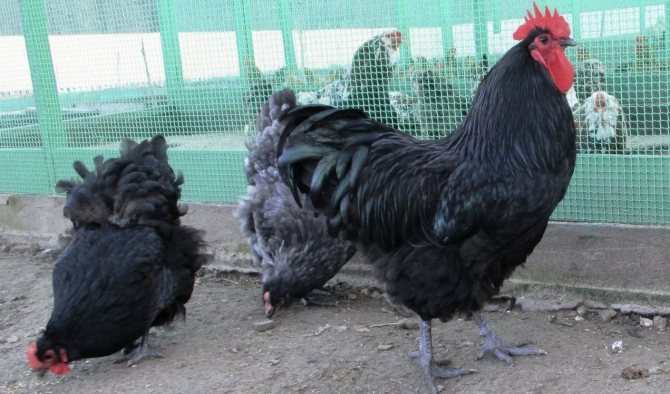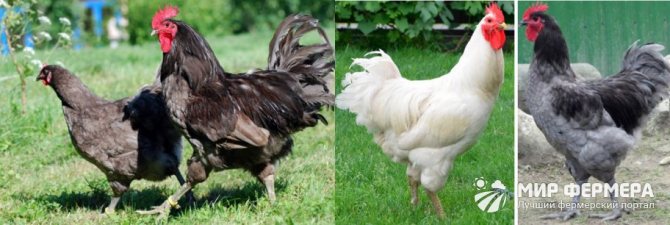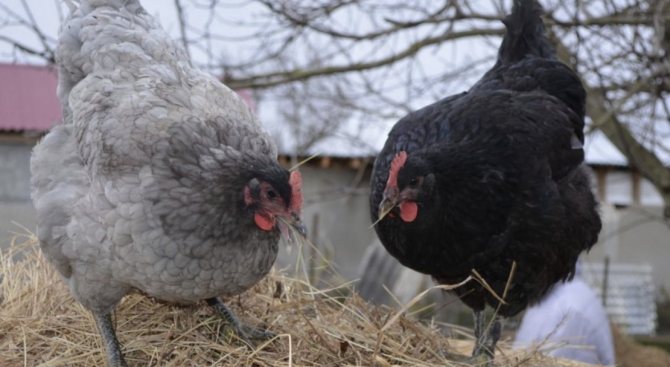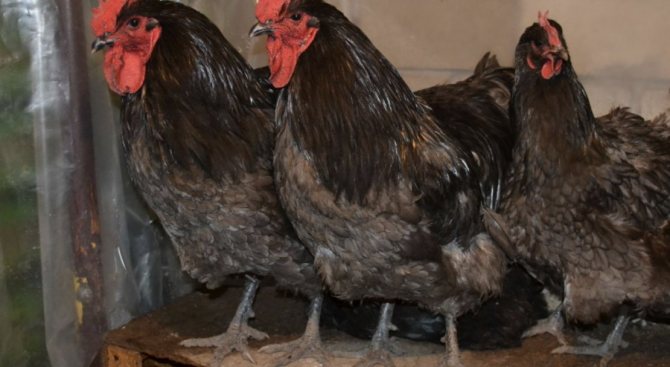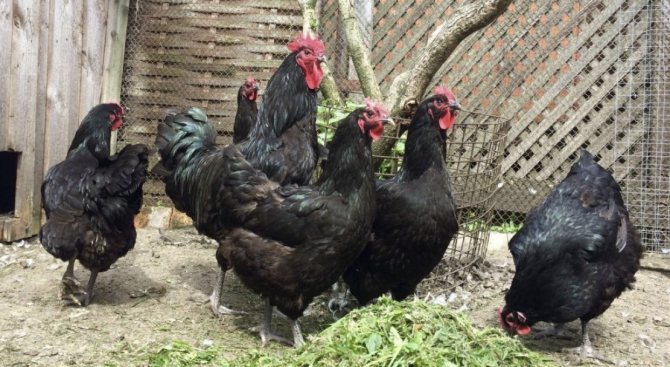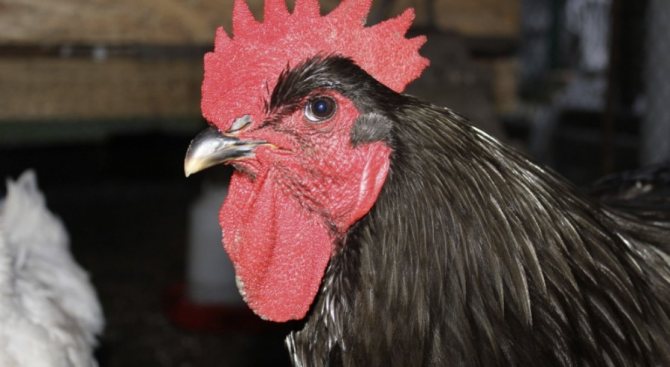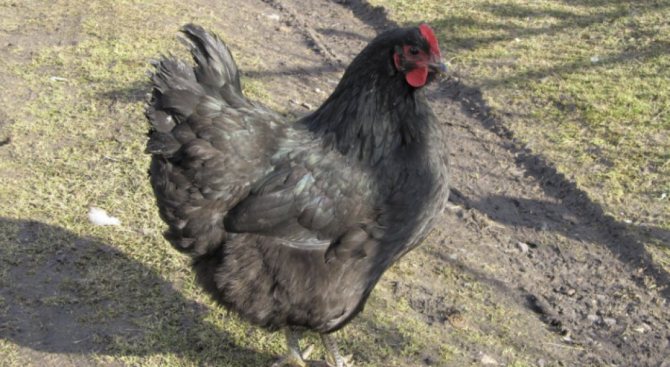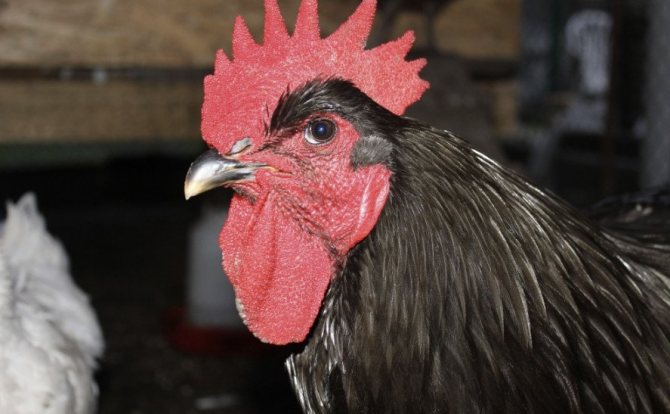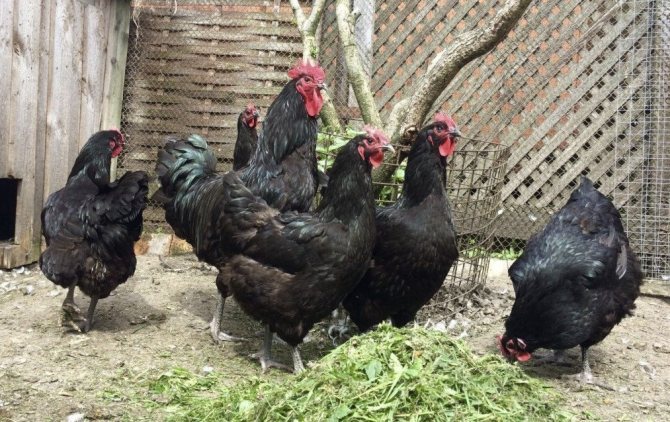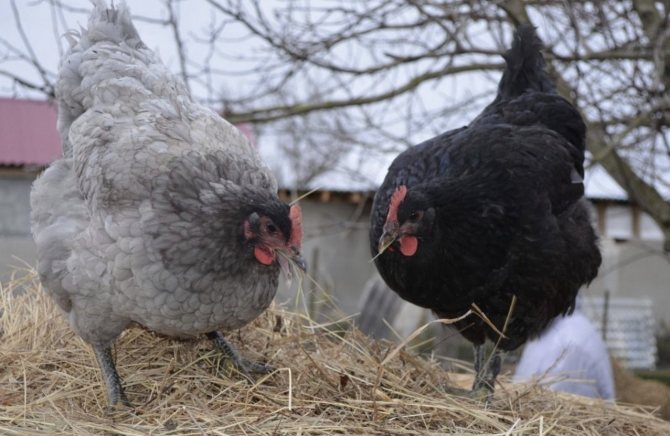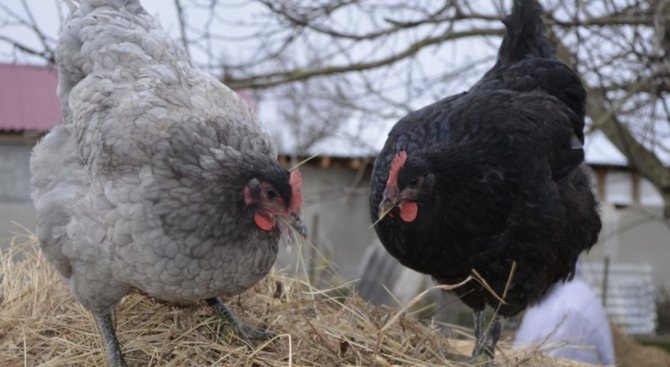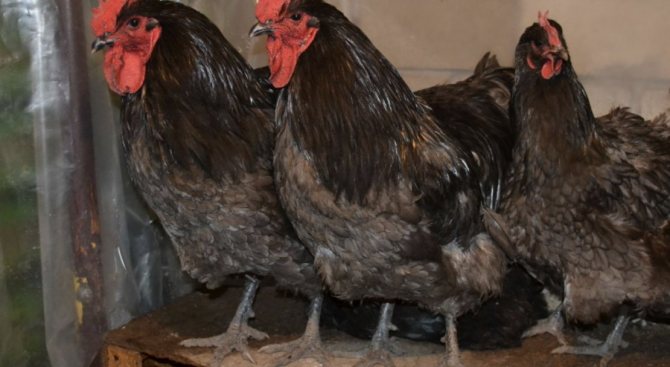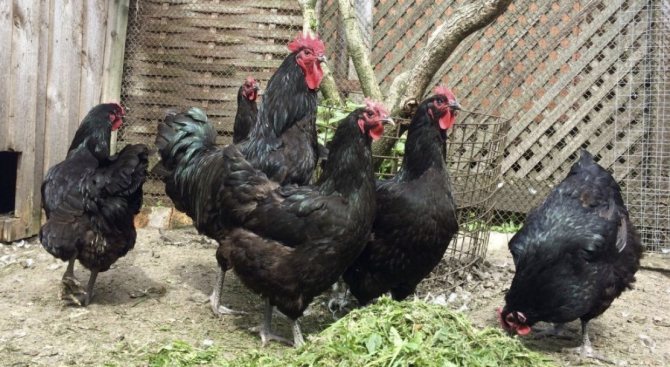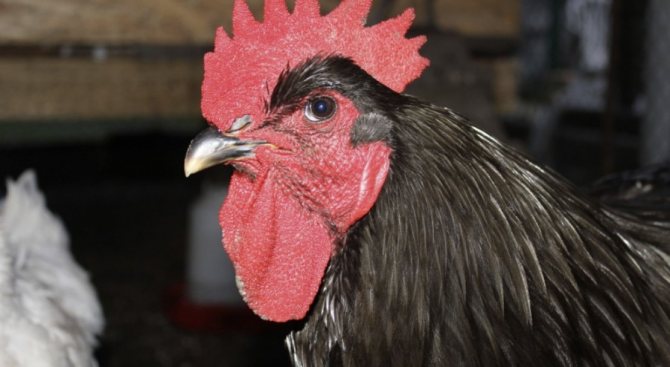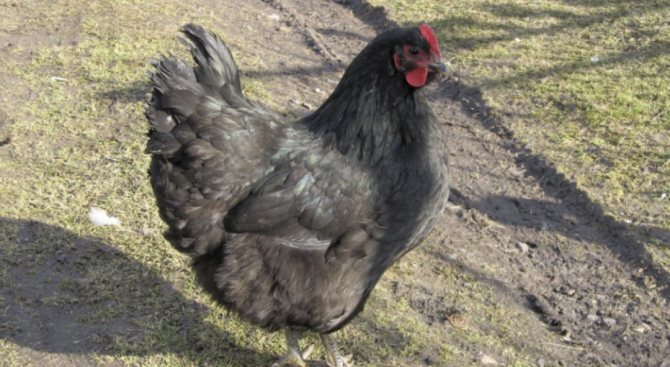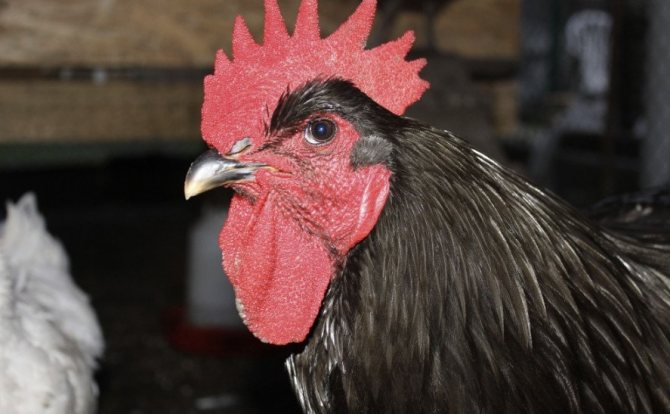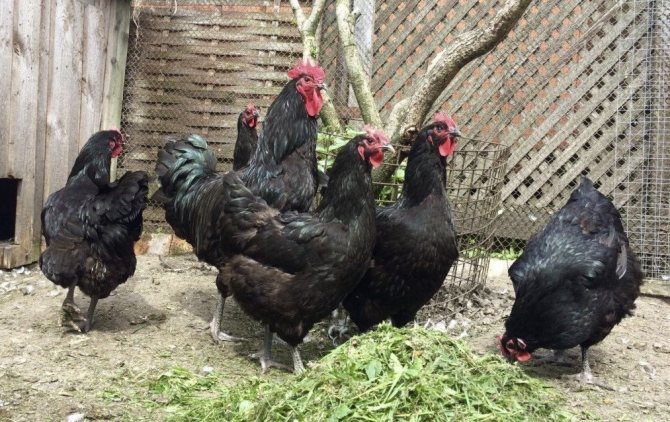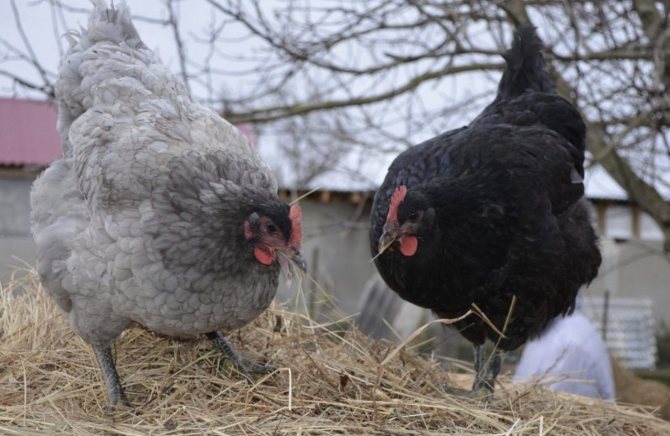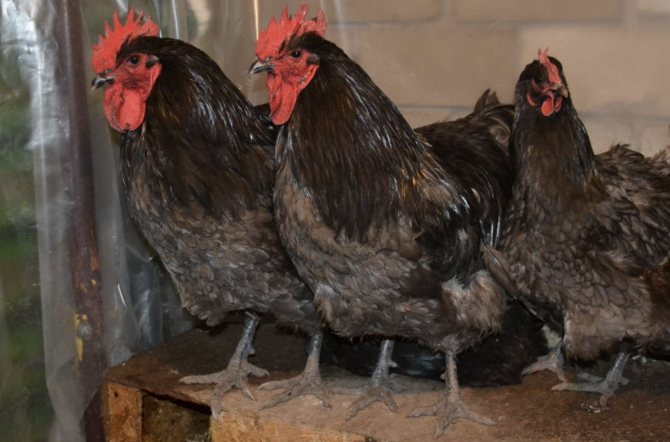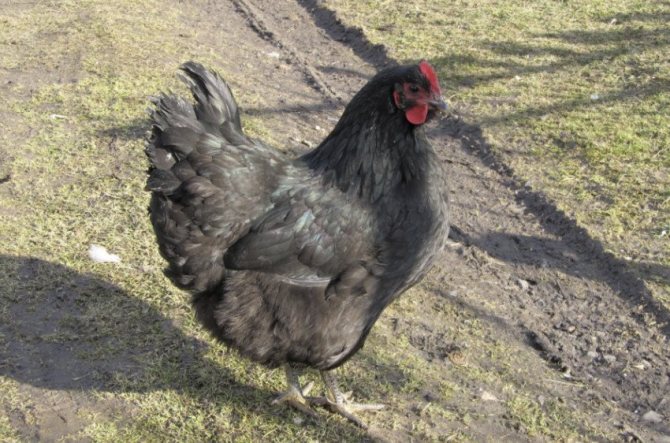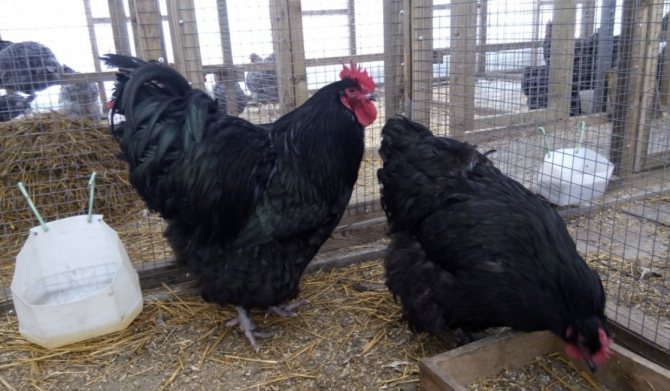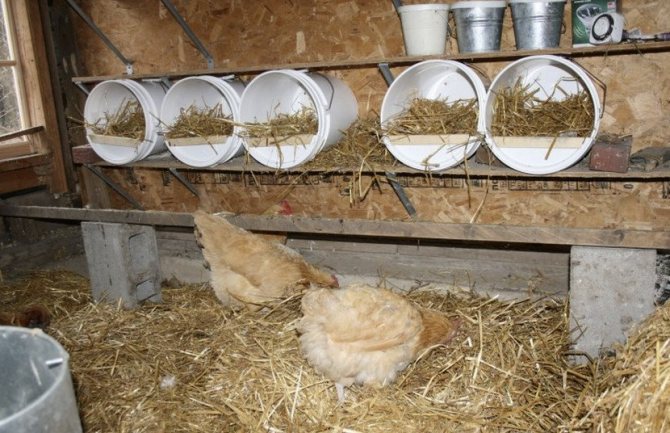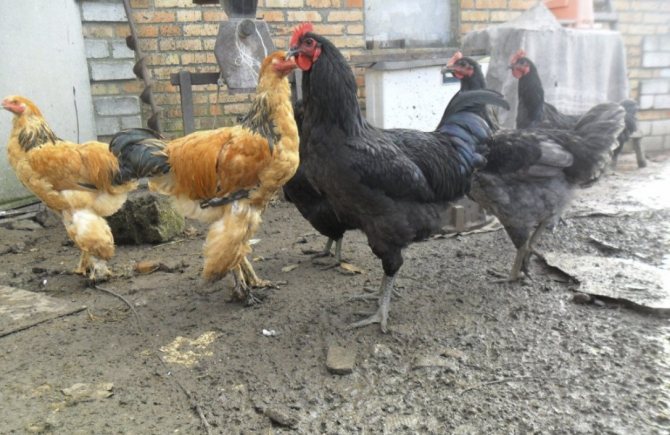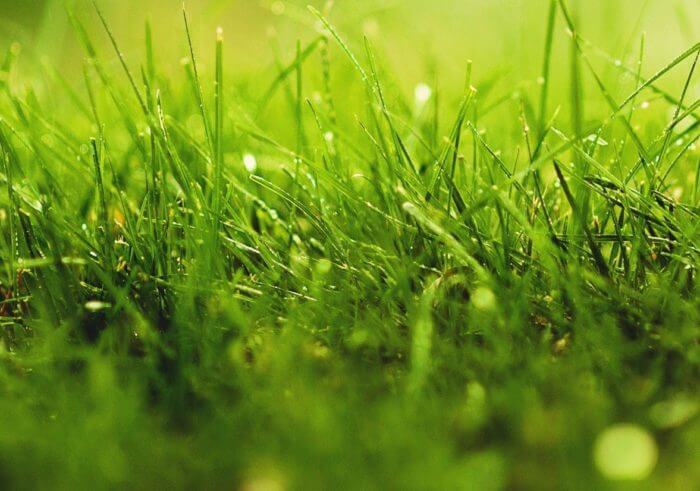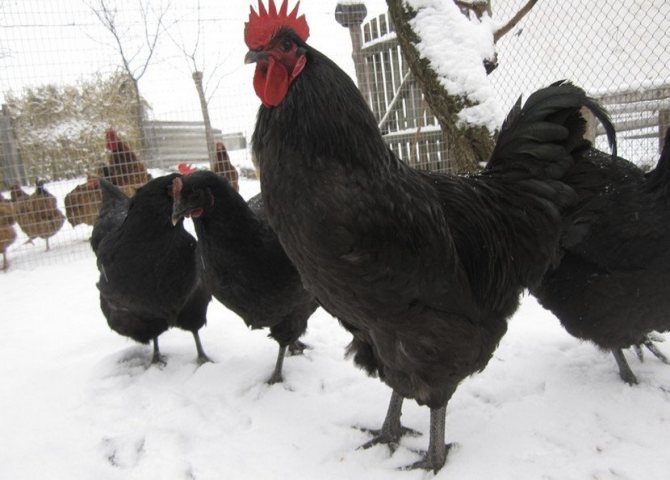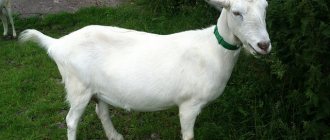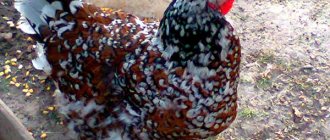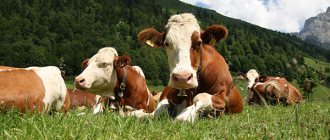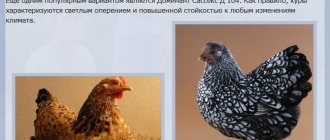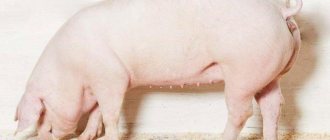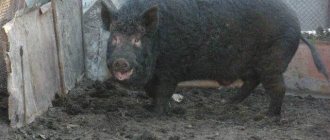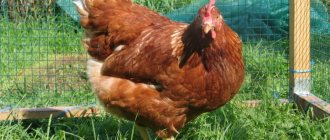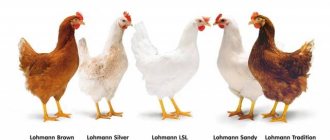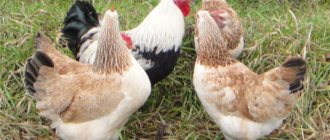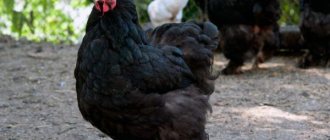Almost every owner of a private house or summer cottage keeps chickens in his courtyard, because these unpretentious birds allow you to get fresh high-quality eggs and meat all year round. Naturally, for this purpose it is necessary to choose the right breed with a meat or egg production direction.
The Jersey giant is considered one of the youngest, but no less promising breeds. Representatives of the species have many advantages, but at the same time they also have some features that must be taken into account when keeping and breeding. In this article, we will consider not only the features of the appearance and character of the Jersey giants, but also pay attention to the main nuances of keeping and feeding these birds.
Breed of chickens "Jersey giant", description and photo
Jersey is a relatively young breed of chickens, which will turn one hundred years old in 2022. But many other chicken breeds are older.
Jersey Giant chickens were bred in New Jersey by breeder Dexter Uham. There is an assumption that in fact John and Thomas Black worked on the development of this breed of chickens in Burlington County much earlier, crossing large breeds of dark-colored chickens. As a result, Jersey giant chickens are larger than any other meat breed of chickens.
Health
Like other chicken breeds, the Jersey Giants suffer from mycoplasmosis. Therefore, you need to closely monitor the bird for the first 2 months, especially in cases where it is purchased from dubious sellers. It is recommended that recently acquired individuals be kept isolated from the general herd at first.
Parasites, feather eaters, ticks and fleas can become a real scourge for the poultry farmer. The carriers of these harmful insects are wild birds, it is almost impossible to protect your pets from them during grazing. But there are well-proven folk remedies for combating them. Ash baths are an excellent prophylactic agent. Chickens are happy to "bathe" themselves in the ash poured into a trough or just in a heap on the ground. Also, pharmacies sell special solutions that inhibit parasites. Bathing an infected bird in them will drive the pests away.
Productive characteristics
The Jersey giant is growing very quickly, by the year the roosters already weigh 5 kg. The most active growth occurs in the first five months, then the daily weight gain decreases and the content of the young beef herd becomes unprofitable.
The Jersey chickens left for the tribe lay their first eggs at the age of 6-8 months with a body weight of 3.6 kg. A fully grown Jersey layer weighs one kilogram more. For the beef breed, the Jersey giant has very good egg production rates: 170 eggs weighing 70 g per year. The eggshells of the Jersey giants are brown. With good quality feeding, it is strong.
general characteristics
The Jersey giant does not stand out for its striking exterior, but it is often in the center of attention due to its noticeable massive build.
Appearance
| External waters | Description |
| Head | large, proportional |
| Crest | large, erect, six-toothed, red |
| Earrings and lobes | large, rounded, no folds, red |
| Beak | medium, strong, curved, black or yellow (for white color) |
| Neck | strong, curved |
| Housing | tightly knocked down |
| Back | wide, almost parallel to the ground |
| Chest | strong, wide, protruding forward |
| Wings | medium, adjacent to the body |
| Tail | lush, of sickle-shaped feathers, at a rooster at an angle of 45 ° to the back; the chicken is slightly shorter and more luxuriant, at an angle of 30 ° to the back |
| Paws | four-fingered, black or gray; muscular thighs and lower legs |
| Plumage and color | shiny, well-fitting, black, white or ash blue |
Did you know? Chickens are the most common birds on Earth. Their images are found on the coins of 16 countries of the world, and the rooster is unofficially considered the national bird of two countries - France and Kenya.
Productive qualities
Representatives of the breed grow rather quickly, their most active development occurs in the first 5-6 months of life. If chickens are bred for meat, then they are usually slaughtered in the sixth month, otherwise keeping birds becomes unprofitable.
Price
The Jersey giant is a rather rare breed for Russia that is in constant demand. Due to this, the cost of an incubation egg is not cheap: about 300 rubles without delivery.
The egg can be considered incubation one month after the first clutch. It is not worth increasing the number of males in a herd to increase egg fertility up to 100%. An excessive number of them, on the contrary, can be harmful. Competing, roosters can interfere with each other.
Physical troubles are caused to chickens by too frequent coverage: from the back of weaker chickens, heavy cocks pull out feathers. Such activity of the leaders of the flock should be under the supervision of the poultry farmer.
If "bald patches" and wounds are found in the area of the back in the plumage of chickens, it is recommended to put on special blankets on them, which will provide protection during "love games". The optimal ratio of males to females for the herd is 1:10.
To obtain a high-quality hatching egg, special attention should be paid to the weight of the representatives of the parent flock. Obese and overfed individuals are not suitable for this honorable mission.
Overweight males and hens have difficulty mating, which can lead to reduced egg fertility. For this reason, a few months before the start of hatching egg collection, it is recommended to limit the feed intake of the birds in order to normalize their weight.
The parent stock must be separated from the representatives of other breeds, otherwise the offspring may be unclean. The Jersey giant has a weak incubation instinct, like other meat breeds.
A hen that starts work can crush some of the eggs due to its weight. In this regard, it is advisable to use an incubator.
Feeding the young
Do not seek to feed future giants immediately after they hatch from their shells. For the first 12 hours, their bodies still have enough food obtained in the egg. Because of this, the crumbs do not eat very willingly on the first day of their life.
But, after 12-14 hours, be sure to feed the crumbs, and do not forget to serve them clean, warm water. It is important to understand that the body temperature of babies at this age is about 40 degrees, and if the water is just at room temperature, after drinking it, they can get hypothermic, weaken and get sick.
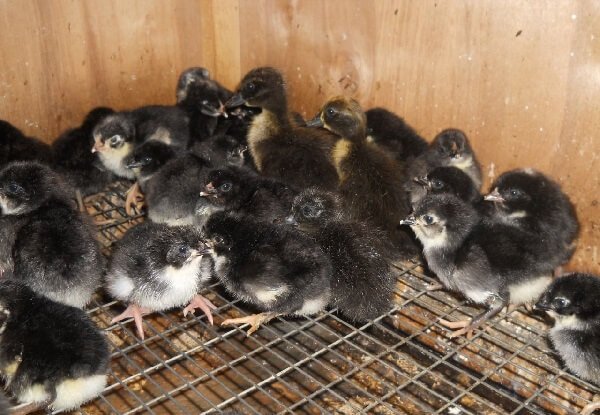
Here are the rules for feeding these chickens.
- Give babies glucose solution (available at the pharmacy) from day one. In no case should it be confused with regular sugar syrup, which can destroy your brood. Vitamin C can also be added to this liquid.
- Let the growing children eat every 2 hours, because they very quickly assimilate food, which goes into growth and to support life in the body.A lack of food or too long a time gap between meals can affect their health.
- Remember that you need to feed the young in moderation, calculating the amount of food so that they do not overeat and do not starve. Both negatively affect growth and development.
- In this case, it is advisable to give baby mash of eggs, cereals and herbs only in the first week of life. Then you can safely switch to more high-calorie foods.
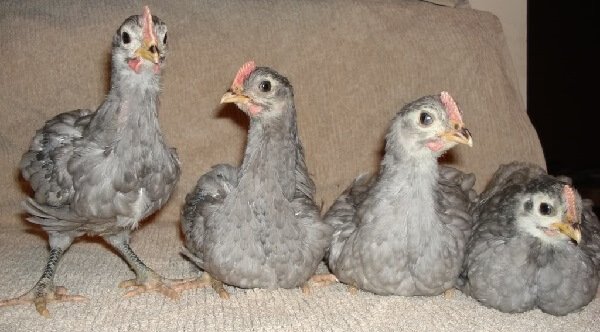

- Cottage cheese aids digestion, helps strengthen and grow bones, and is the best source of protein for muscle development. It can be given to crumbs from the 3rd day no more than 1 time per day.
- From 10 days you can start giving the crumbs crumbly cereals from millet, millet. Mixtures of boiled vegetables, small cereals, and vitamin supplements appear in the diet.
- Health and immunity are formed at a young age, so add fish oil to babies to keep them strong and resistant to disease.
- Jersey chicks are a good place to look for ready-made high-protein combo feeds on the market. Pay attention to the nutritional value and composition - it must meet the needs of the grown giants, and contain a lot of protein.
Pros and cons of the Jersey giant
The advantages include:
- unpretentiousness to conditions of detention;
- docile and calm character;
- well-developed hatching instinct;
- fast growth;
- high percentage of meat yield.
Disadvantages:
- obesity tendency;
- the need for a large living space;
- loss of taste of meat at the age of poultry older than a year.
Since the unpretentiousness of the Jersey giants to the conditions of detention due to the requirements of a large range is somewhat exaggerated, it is logical that the Jersey breed did not become widespread on an industrial scale.
Where can you buy in Russia?
Jersey people are popular in our country due to their large body weight, beauty and taste of meat and eggs. Numerous farms and farmsteads are engaged in and breed them. Here are the contacts of some of them.
Reviews of poultry farmers
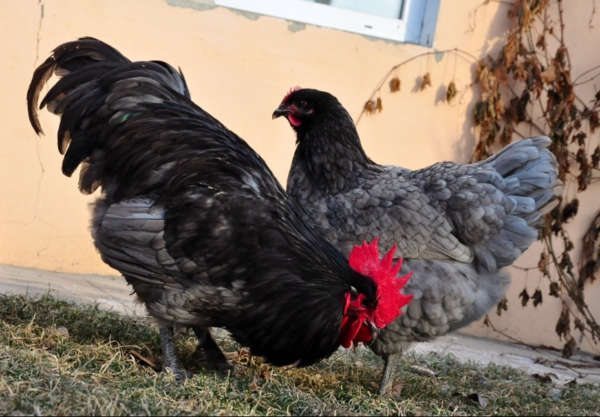

The Jersey giant chicken breed has fallen in love with many poultry breeders who successfully breed it and leave their positive reviews.
Among the advantages of the breed are called:
- good quality meat in large quantities;
- the survival rate of young animals is 82-85%;
- resistance to colds;
- fast weight gain.
Among the few shortcomings of the breed, poultry farmers note an increased amount of feed and an increase in the area of detention per individual.
Photo gallery
Next, you can see the breed of huge Jersey giants chickens in the photo. The first two photos were taken at one of the poultry farms in Russia, which also breed our heroes:


And this is what the chickens look like:
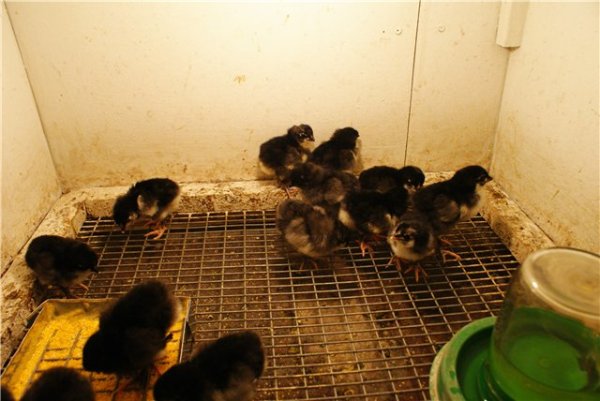

Very young chickens that have not yet reached their record sizes:


As mentioned above, these birds are able to feed on what they find. This is what this cock is doing:


And here is the chicken coop for these birds. And again in search of food ...


Break of laying and moulting
In the first year, moulting in chickens can begin in the spring, later this process usually falls in the fall. During the molt period, the bird stops rushing, eats less and is not as active as before. On average, molting lasts 4-8 weeks, but for various reasons it can take up to three months. These reasons are:
- too poor diet;
- avitaminosis;
- infestation with helminths and insect parasites;
- diseases;
- stress due to relocation or new chickens.
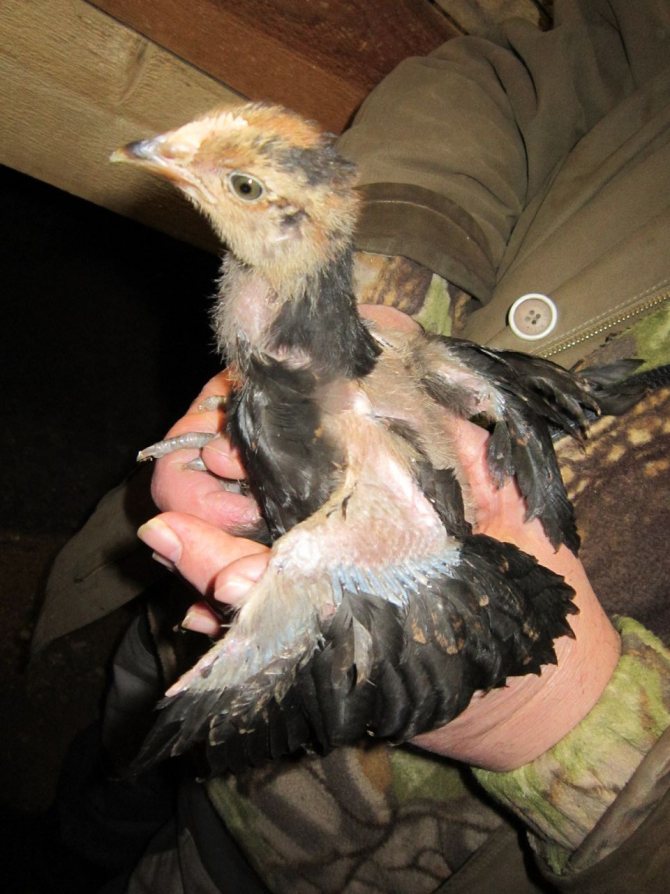

Molt
The duration of molt affects egg production: the faster the molt ends, the better the chicken will lay. Heavy chickens tolerate this period worse, so you need to carefully monitor them and provide the best care. Vitamins B1, A, D and B3, iodine and manganese preparations should be included in the diet.If possible, feed the chickens with fresh viburnum berries; hawthorn and black chokeberry are also suitable.
Advice. During the moulting period, chickens are especially susceptible to disease, so they should not be allowed to get wet in the rain or spend the night in a cold enclosure.
Heavy chickens sometimes molt during the summer months. Experienced breeders recommend discarding such individuals, since they will not be good layers. If during molting the hen becomes too lethargic, walks and eats little, you should immediately show it to the veterinarian, since a healthy bird should not behave this way.
Content specifics
The Jersey giant can adapt to being kept in a cramped space, but its health condition will leave much to be desired. When keeping chickens indoors, it is necessary to take care of well-designed exhaust ventilation, which will remove the ammonia that accumulates in the floor area. Chickens love to lie in bedding, and the Jersey giants are no exception. This is where the ammonia released from the decaying droppings is collected. With the systematic presence of high concentrations of ammonia in the premises, the death of the livestock may begin.
Important! All chickens tend to settle somewhere higher for the night, therefore, given the awkwardness of the Jersey giant, it is necessary to lay soft bedding under the perch. In this case, the chicken, even if it falls, will not hurt itself.
Jersey chickens tolerate Russian winters well and are able to walk in open-air cages during the day. The open-air cage area for one Jersey chicken is 0.5-1 m.
Due to their large body weight, Jersey chickens do not fly (however, it is not known whether the Jersey themselves know about this), but it is better to enclose the aviary with a high enough net or make it with a roof so that smaller breeds of chickens, who know for sure that they can fly, could not enter the enclosure to the Jersey giants.
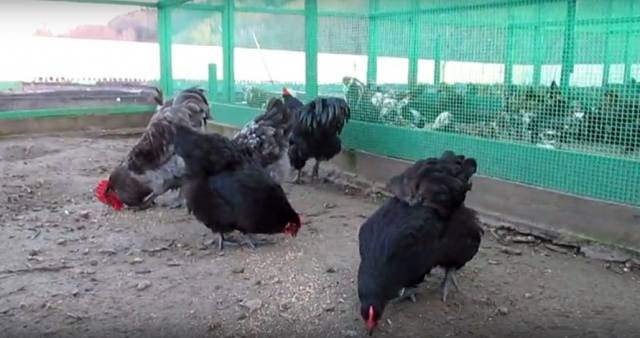

Yes, this is how your aviary will look like in reality instead of advertising green grass with Jersey chickens walking on it.
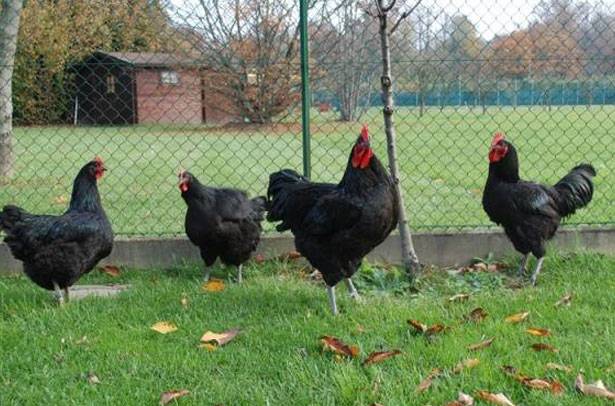

Moreover, with the declared density of chickens per unit area of the enclosure, it will look like this at most in a month.
To completely clear a plot of land from grass, insects and underground larvae with earthworms, it is enough to fence it and run chickens there. The population density of chickens depends on the time allotted for cleaning the site. One chicken per 50 m² will cope with the task in 2-3 months, if the site is not overgrown with weeds, and in six months, if powerful plants need to be destroyed. It is not recommended to leave chickens for a longer period, the trees may also end.
In fact, chickens really need to be given green grass and vegetables, but it is better to harvest it yourself and give it in a specially built aviary for them than to let it go in search of pasture.
Conditions of detention
If you organize aviaries for chickens, you can reduce the consumption of feed in the warm season by up to 70%. During the winter months, the birds are provided with a diet that is the same for heavy breeds. The main thing is not to forget about the containers with gravel and feed chalk, which are filled as needed.
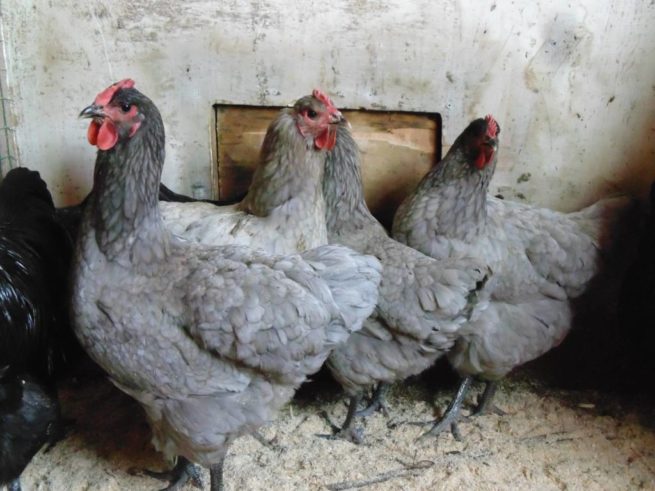

You can also contain giants without a walk. But in the room, certain standards must be observed, which are not less than 0.5 square meters per bird. Also, the hen house should have windows for the penetration of natural light, and for ventilation.
The litter is laid in a thick layer, and when it begins to cake, shake it up and add new material as needed. Due to the lack of flight ability, perches and nesting houses need to be installed at a low altitude. It is recommended to equip nests with special ramps along which the eggs will roll into the pan so that they are not damaged by chickens.
Origin story
The homeland of the Jersey giant is North America, New Jersey. According to official data, the breed was bred by the breeder Uham Dexter in 1915. To obtain a new cross, the farmer used representatives of Brahma, Langshan and Orpington. The first Jersey had black plumage.
There is another version of the origin of the breed. According to it, back in the 19th century. At John and Thomas Blackie's farm in Burlington County, chicken breeders have experimented with crossing blacks for 20 years. At the same time, the same breeds were taken for the experiments as those of Uham Dexter, as evidenced by the corresponding records. Therefore, it is likely that the idea of obtaining a cross was borrowed from its predecessors.
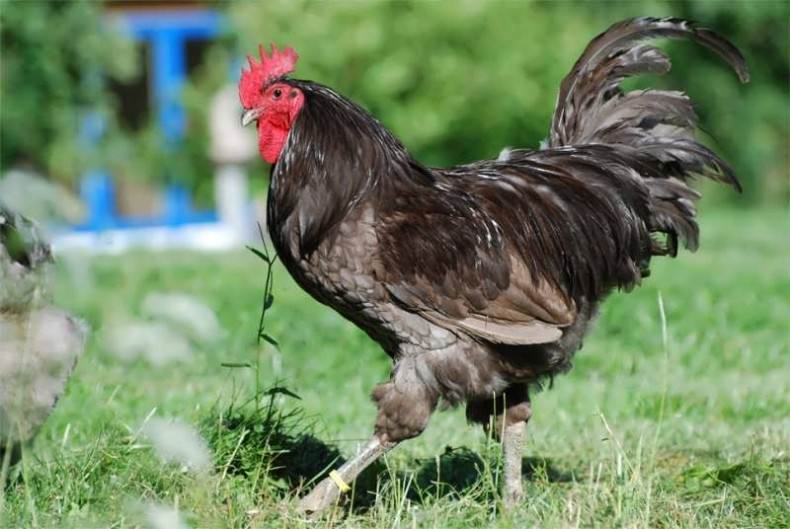

In the 21st year of the last century, the Jersey giants were brought to England. British scientists-breeders decided to diversify the breed by changing the color of the plumage of the bird. 1922 saw the official introduction of black plumage into the list of United States standards for jersey.
As for the experiments on the color of the Jersey, the idea of the British seemed very attractive to breeders from Europe. As a result, decades later, a blue variety of the Jersey giant (1982) was bred and officially registered in Foggy Albion, and 12 years later, but already in Germany, a cross with white plumage was registered (1994).
By the beginning of the new millennium, the wave reached Russia, creating a real sensation among domestic farmers. Taking into account the experience of the Europeans, Russian poultry farmers laid the foundation for the cultivation of American giants on their farms.
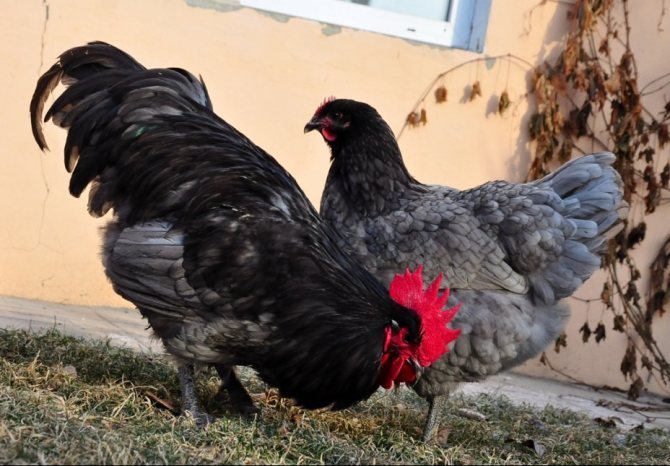

Breeding
If you decide to start breeding the Jersey giant, and the neighbors of chickens do not have this breed, it is irrational to drag live adult chickens from afar. It is much easier and cheaper to buy hatching eggs and, following the instructions, hatch the desired chicks.
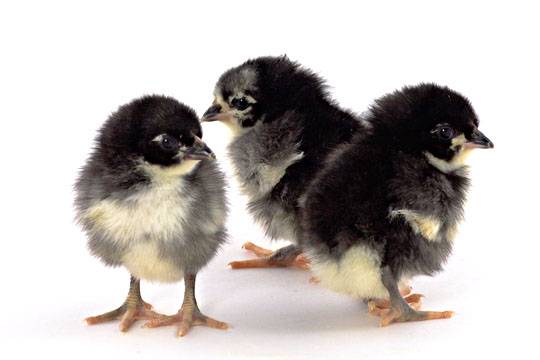

On the first day after hatching, chicks usually do not eat, even if they have food in front of them. But they need water. It is better if it is heated up to 50 °.
In the first days of life, not only Jersey, but also any other chickens need to be given a chopped egg, since growth during this period is very rapid and babies need a large amount of protein to build their own body. Or you need to take care of a special feed for Jersey chickens in advance.
General recommendations for growing chickens boil down to compliance with just a few conditions:
- air temperature not lower than 25 °;
- long daylight hours;
- lack of drafts;
- clean heated water;
- special feed for chickens;
- vitamins and antibiotics.
Unfortunately, infections often roam in industrial incubators, so antibiotics will be needed for chickens. In the future, if your chickens are healthy, then chickens do well without medication.
Attention! The minimum mortality in chickens is observed if heat and light come to them from above (an ordinary incandescent light bulb suspended in a box so that, without burning the chickens, heats the air).
The power of the light bulb and the level of heat generated by it are selected depending on the ambient temperature. If the street is +30 and above, then the light bulb needs a minimum power, only for lighting.
The principle here is simple: if you don't know how to do it right, do it as in nature. In nature, chickens receive heat from above from the body of a brooding hen. At the same time, they may have wet ground under their paws. Therefore, the cold floor is not so terrible, although it cannot be cold with a bedding, as the inability to warm the head and back.
Grown up Jersey chickens are capable of breeding from six months. The ratio of hens and roosters should be 10: 1. Jersey giants are good brood hens, but due to their large body size and some awkwardness, chickens can crush eggs or throw them out of the nest. Therefore, eggs from under their Jersey chickens must be collected and also placed in an incubator.
If it is necessary to preserve the purity of the breed, the producing herd should be kept separate from chickens of other breeds.
The arrangement of housing and an aviary, as well as the feeding of Jersey chickens, can be seen in the video
The intricacies of the content of the Giants
Everyone is interested in the bird producing eggs in winter. And for this, only healthy birds are left and the necessary conditions for keeping are created.
Such a picture is not uncommon: the farm is insulated - all the cracks are sealed, a seal is installed on the doors and windows, and there is no bedding on the floor.
Be aware of the quality and thickness of the litter, as body heat is not transferred to the paws of the bird, even while it is sitting.
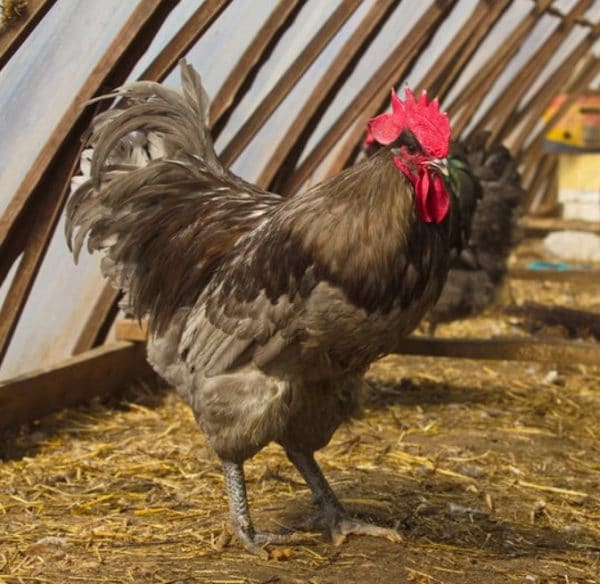

Jersey giant
Moss, straw, shavings, peat, and even dry leaves are suitable as bedding.
The use of sawdust leads to serious diseases, because the young eat small wood with pleasure. So only shavings will do. Therefore, for young animals, even cover sawdust with straw cutting.
If adult birds are undernourished, then they willingly eat sawdust. With this in mind, check your feeders regularly for feed. The thickness of the bedding layer is chosen depending on the season and age of the bird.
Keeping hens and young stock
Litter 20–35 cm thick is necessary and obligatory for an adult, and for young animals - 10–25 cm, respectively.
Depending on the degree of moisture, the bedding layer is also laid. The styling is done gradually.
Before laying the litter, burnt lime is scattered on the floor at the rate of 0.5 kg per square meter.
The wet litter is immediately removed, fresh straw is laid.
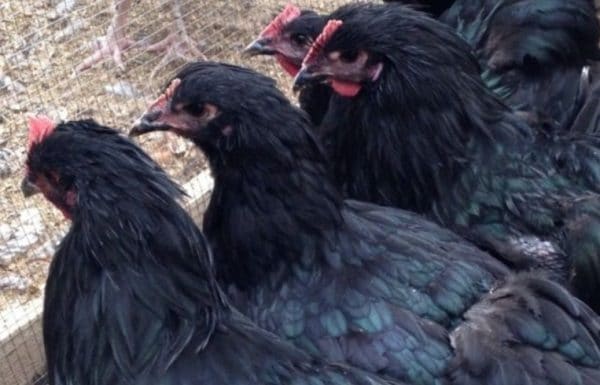

Jersey Giant chickens must be culled for breeding
The litter heats itself up due to internal microbiological processes, in the cold season it is able to heat the shed, because its temperature in the deep layers sometimes reaches 20 ° C.
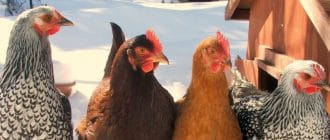

Be sure to read:
The most egg-laying chicken breeds to keep
In addition, the litter layer prevents the development of microbial diseases, the litter is able to protect the livestock from infections. And also B vitamins are formed in it, which are so necessary for the bird in the winter period.
Walking requirements
Jersey giant chickens need regular walking. Chickens need it all the time, so organizing a walk should be taken seriously.
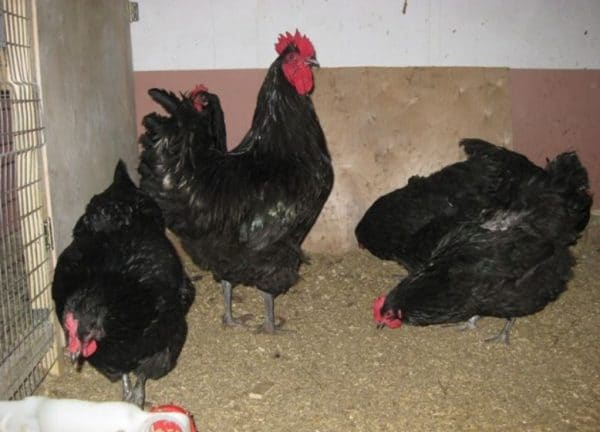

Chickens are calm in nature.
The breed does not require a high fence, since the size of the bird does not allow flying.
The main plus of the breed is that the birds are omnivorous and do not need any additives, which helps to reduce the cost of buying feed.
Conditions for winter
To increase egg production in the cold season, artificially extend the daylight hours. Lighting is provided in the barn. To do this, use a rheostat or simply hang a couple of bulbs.
"Don't make the lighting very bright, use 60 watt bulbs."
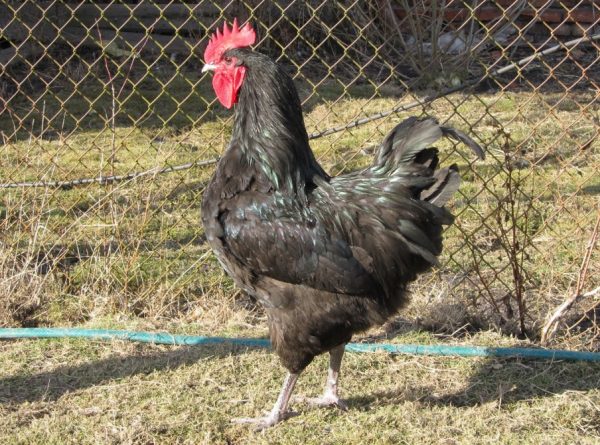

Jersey giant
In the fall, take care of the formation of the chicken herd for the next season. Only healthy, strong birds are left for the winter quarters. If you create favorable conditions, then the Jersey will delight in egg production throughout the winter.
Young growth care
Attention should be paid to drinking: chickens should be given boiled water regularly.
When faced with the fact that chickens are inactive during the first days of life, do not worry: this is normal. The reason is that the chicks simply have not yet had time to digest the nutritious mass that they ate at the time they were in the egg.
"The ideal bedding for small Jersey chicks is compound feed."
Young animals are kept in dry, clean, ventilated rooms.
"In the first days of life in cages or rooms, maintain a temperature of 30 - 32 ° C, for this, install a thermometer in the cage or box."
The chickens themselves can "tell" how they feel.
If the temperature is normal, the chickens are mobile, eat food and drink water, and are evenly distributed over the area of the cage.
If the chickens are hot, they open their beaks and spread themselves along the cage wall, spreading their wings.
Chicken boredom indicates that it is cold in the coop.
With high humidity, the chicks become lethargic, breathing difficult.
In cages with dry air, feathers become dry, brittle, disheveled, chicks lose their appetite, often drink water.
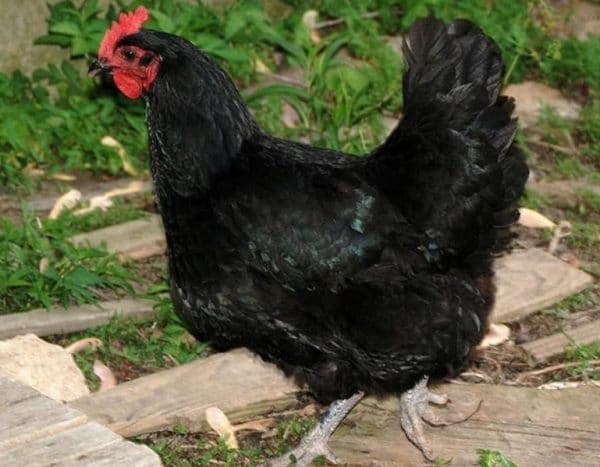

If the temperature is normal, the chickens are mobile, eat food and drink water, evenly distributed over the area of the cage
In the first days, in addition to maintaining the temperature at 30 - 32 ° C, electric or water heating pads are placed on the floor of the cage or box. From above, you can also hang light bulbs up to 60 watts.
Nutrition for adolescents
For the first sixty days, chickens are usually kept in a separate, lighted, draft-free room.
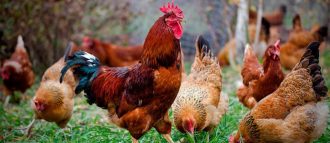

Be sure to read:
Ideal beef breed - Kuchin anniversary chickens
Content rules:
- The required temperature for them is 25-28 degrees Celsius.
- Chickens need feed with a decent amount of protein - meal or, if available, cake.
- It is advisable to use balanced supplements that contain useful substances necessary for the growth and development of chickens.
- In the early days, they are fed with small amounts of egg yolk, and low-fat cottage cheese is given.
Feeding hens
It is not difficult to choose layers: they have an elastic bright red comb, an unconsolidated belly.
If you find that the chicken is in the process of molting, keep in mind that in the next month or two it will not lay eggs, since the bird will direct all the resources of the body to restore feathers.
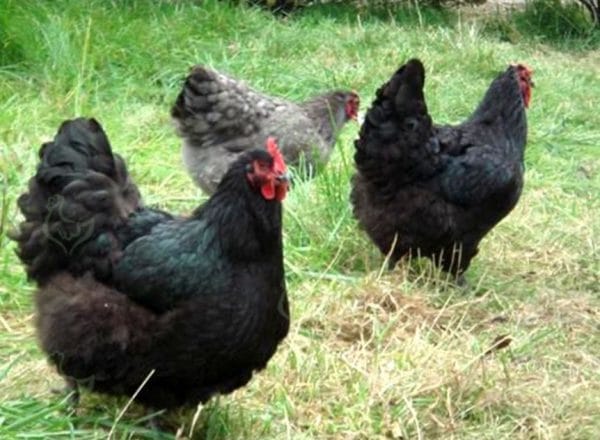

Choosing hens is easy: they have a firm, bright red scallop, unconsolidated belly
Experienced poultry farmers recommend stocking up on feed in advance. For feeding, you will need not only grain, but also protein feed. Take care of purchasing sunflower meal, soybean meal, fish meal or bone meal.
“In winter and early spring, wheat is germinated and chickens are given 50–70 g per head every day.”
In addition, cereals lend themselves to yeast, thereby increasing the level of nutrients in them.
Young growth care
An insufficient amount of protein and calcium in the diet slows down the growth of chickens, leading to illness or death. Youngsters who have not received vitamins A, D, E at the time of active growth "sit on their paws." It is quite difficult to get him out of this state. It's a shame that in the future, a chick who has been ill will be able to become a breeding bird.
It is recommended to place newly hatched chicks in a warm place, with a temperature in the range of + 26C - + 28C. Drafts and excessive moisture have a detrimental effect on babies.
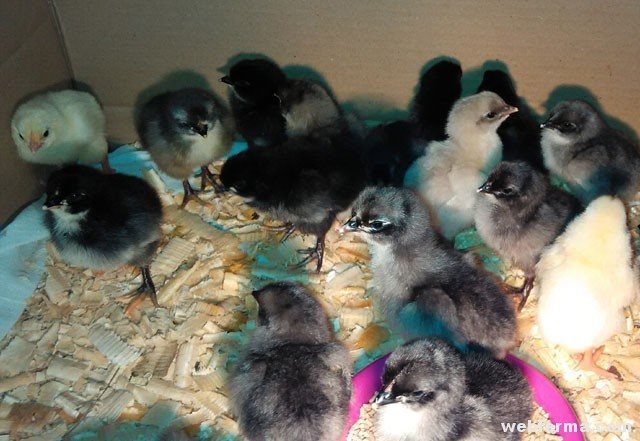

A good option is also to place day old chicks on large shavings, as in our photo.
Dry compound feed or wheat bran can be used instead of bedding. The chicken is still very weak, it will prefer not to run or stand on its legs, but to sit - a soft bedding will be just right for it. And if he suddenly decides to refuel, he can peck a few grains of compound feed, without even getting up.
Feeding
But it often happens that the chickens refuse to eat all the first day. There is no need to worry about this. It only means that the chick has enough embryonic yolk. In the first day of life, it must dissolve in the esophagus and be completely absorbed by the body, strengthening its immune system. It is not worth feeding the chickens additionally on the first day.
But it is imperative to drink! Moreover, the water in the drinking bowl should be quite warm, almost +50 degrees. It is also recommended to add vitamin C and glucose to it. It must be remembered that cold water at the very beginning of life can be fatal to chickens. It is also necessary to constantly monitor the purity of the drink. If droppings enter it, it will cause poisoning.
Experienced chickens are not advised to place the brood in a closed box for the whole day. The amount of light and oxygen should be sufficient even in the first days after birth.
It is recommended to feed chickens often, up to 6 times a day. The first 1-2 days you need to give them steeply cooked and finely chopped chicken yolk at the rate of 1:20. Then you should switch to a feed mixture specialized for chickens.
Eggs should not be given after babies are three days old. It is very useful to feed chickens with boiled millet, crushed wheat and corn, fresh non-acidic natural cottage cheese. The porridge must be drained through cheesecloth, the cereal must be crumbly and free of liquid residues, not stick together. Otherwise, babies' nostrils will clog and they may suffocate.


At first, juveniles should be kept separately in commensurate pen-cages.
On the third day, the diet of chickens should include natural vitamin supplements in the form of nettle, clover, alfalfa. You can mix chopped greens with grain or mixed feed mash. After the birds get used to it, bunches of grass are hung along the walls at the level of the chicks' eyes.
Gradually, at about one week of age, chickens should begin to receive boiled carrots, potatoes. Root vegetables should also be added to the mash. To strengthen the immune system, fish oil is dripped into the morning food.
At the age of 2.5-3 months, the young Jersey giant begins to "accelerate" growth. At this time, special attention should be paid to the amount of protein in their diet. Adding boiled fish and meat, legumes, barley, dairy products, if possible bread (fresh or soaked) to the mash, will help the bird gain the necessary weight. The amount of vitamin supplements - shredded vegetables, herbs - is given in unlimited quantities during this period.
Feeding
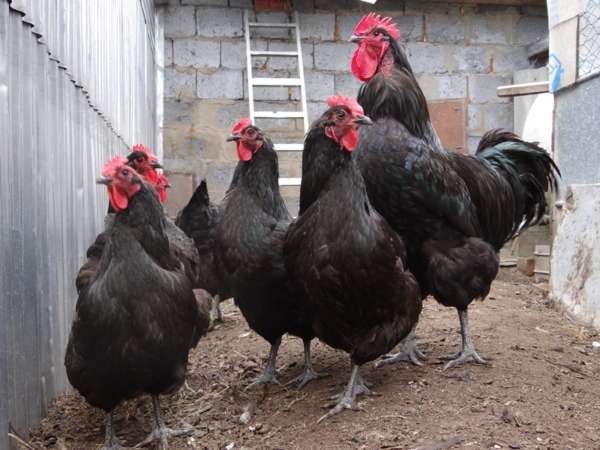

Jersey giants need to be fed 2-3 times a day, preferably with a damp mash of mixed feed. The best for them is one consisting of forage and coarse grains. It is especially useful to give such a mash to the birds at night, allowing them to gorge themselves and go to bed with full goiter.
This feeding regime increases egg production and provides weight gain. The shit contained in the compound feed cleanses the esophagus.
Meat breeds of chickens should receive a balanced feed on a daily basis:
- 40% wheat;
- 40% corn;
- 10% shell rock, cake or meal, fortified supplements.
Chicken farmers who raised the Jersey giant speak of an adult bird as an excellent forager. During the spring-summer season, when releasing a bird to the pasture, you don't have to worry about feeding it: Jersey people are happy to eat caterpillars, worms, ants, pebbles, grass seeds.
This allows you to reduce the consumption of additional feed by almost 70%. If the bird is kept free, artificially produced vitamin supplements are not required, which makes it possible to significantly save on feeding it.
Keeping hens


Regular egg production requires light, warmth and a balanced feed. Particular attention should be paid to the presence of calcium in the diet of layers. In a separate feeder, there must be sand, shell rock, crushed limestone.
Among all the known breeds of the Jersey giants, they are distinguished by poise and tranquility. This fact also has a positive effect on egg production: in the absence of stress, laying hens lay eggs stably and evenly.
The heavy weight of the laying hens sometimes crushes eggs that have already been laid in the nest by other hens, and may even discard them.
The poultry farmer should do his utmost to prevent losses. More frequent collection of eggs does not guarantee the complete safety of clutches. To solve this problem, nests are specially equipped with a slope and a hole into which the egg rolls out.
Features of the
The breed is perfect for self-sufficiency in meat and eggs.The bird is large, well-fed, and lays eggs well.
Grows fast, gains weight well, therefore in 1 month requires a large amount of fertilizing, vitamins and calcium so that their musculoskeletal system develops normally. Care of the young is very important so that a truly large and hardy bird grows as a result.
Health is excellent, this breed does not even care about bad weather conditions. The character is calm, not evil, giants are kind and balanced birds.
Due to their large body weight, hens can even crush their eggs, it happens that the eggs accidentally fall out of the nest, so it is worth laying their testicles on other quads. And also, due to such a large mass, chickens will not be able to overcome high hedges. Therefore, it is convenient and easy to keep them.
They can spend the whole summer on pasture, feeding on worms, grass and leaves... They are very fond of walking around the yard, they need a lot of space next to the chicken coop for exercise. In late spring, summer and autumn, compound feed consumption is reduced by almost 70%, as Jersey are good foragers.
Chickens are neat and disciplined, sedate and completely conflict-free.
On our site you always have the opportunity to see photos of May Day chickens. To do this, just click on the link above. It would be nice to do the insulation of a log house from the outside. It will help you in harsh winters! More details ...
The chicken meat is juicy and tasty. They are kept for meat only up to a year., after a year, the taste and nutritional qualities of meat are not the same. The eggs are large, have a pleasant brown tint, and are very tasty.
The breed is prized for its following qualities:
- High growth rate.
- Decent weight in adulthood (up to 7 kg).
- Good egg production.
- Large eggs.
- Delicious, excellent meat.
Maintenance and cultivation
All the features of the content of the Jersey giants are associated precisely with their weight and large build. Let's consider them in more detail.
- Chickens of this breed a large room is required for their maintenance and a rather large yard for their walking... Due to their weight and size, birds will not be comfortable and cozy in a confined space.
Thus, it is very important to think about giving them a large territory before starting this breed. In a small chicken coop and in a small yard, such sedate and proud birds will have a hard time.If the territory allows, feel free to start as many Jerseyans as possible, they will literally become a decoration of your yard. And their eggs will delight you with their size, shell color, and taste.
- The Jersey giant is a bird of great weight, heavy and large. Exactly because of this reason roosts and nests should not be very high.
It happens that one bird accidentally pushes another, or a rooster, taking off to roost, inadvertently touches someone. Jumping against its will, a heavy bird can damage its sternum. That is why giants should be placed on a bedding deep and soft at the same time, so that possible falls are not so dangerous for chickens. - The Jersey giants have a leaf-shaped crest. It is considered to be the most frost-free. In cold weather, it is recommended to lubricate the comb with oil.... In addition, it is advisable to think about cooling in advance and insulate the chicken coop. You can simply bring the bird to a warm place.
In general, the chickens are happy, unpretentious and resilient. Unlike other breeds, they can walk even in the rain and this does not bother them. Very rarely they are overtaken by any diseases, usually the birds are healthy and energetic.
In spring, summer and autumn, the amount of compound feed is greatly reduced due to the fact that chickens feed mainly in the wild, walk a lot and eat grass and worms.
At sunset, they go to the chicken coop and settle for the night without fuss and scandals, like other chickens. It is not difficult to keep and breed this breed, the main thing is to take into account some of the points indicated above.
Productivity, egg production
In the first year of life, the bird gains most of its body weight, especially actively up to 5 months. Chickens of the Jersey giant breed grow up to 1.5 years, although the growth rate is gradually decreasing. For this reason, it is unprofitable to keep poultry intended for slaughter for more than 5 months.
In the seventh month, by the beginning of egg production, the chicken weighs 4 kilograms. Males at the age of one year weigh about 5 kilograms, at 1.5 years their weight reaches 6 kilograms. With age, the male can reach a weight of 7 kilograms, but this negatively affects his fertilization abilities.
Despite their large size, Jersey giants are distinguished by high egg production. Eggshells are brown, strong. Already at the age of five months, the laying hen can lay the first egg, although this is the exception, not the rule. Basically, the chickens of the Jersey giant begin to lay at 6-7 months.
The first eggs of young layers are small, weighing 55-56 grams. Their weight further increases, reaching in some cases 68 grams. Giant eggs, despite the name of the breed, should not be expected from layers.
One hen usually lays about 180 eggs per year, that is, each hen lays on average once every couple of days. It is interesting that this process does not stop with the arrival of winter. Even in December and January, the most unfavorable months for egg production, poultry farmers report an egg fertilization rate of 82%.
Features of the content
Caring for a bird of this breed, in principle, is not much different from caring for chickens of many other breeds, but it still has some features. For example, due to their large size, the Jersey giants need a large "living space" and this must be taken into account when growing: on each square. m chicken coop can accommodate no more than 2 heads. Although these chickens do not fly, they love to perch. You don't need to make them high. The floor is covered with straw, sand and poured layer by layer as the previous one becomes dirty. Feeders and drinkers should be of sufficient size so that birds can easily get food and water from them. Laying nests should also be loose and comfortable so they don't feel uncomfortable.


In addition to a good-quality poultry house, Jersey should have a sufficient area for a walking yard in which they will walk: without movement, these chickens are sick and do not rush well. Despite the fact that the lush plumage of the Jersey allows them to tolerate the cold well, it is better to insulate the chicken coop for the winter. This is due to the fact that their comb and earrings can freeze even if the temperature drops slightly. For this reason, they cannot be let out into the street in winter at t below - 5˚С.
Prevention measures
It is recommended to observe sanitary and hygienic standards in the poultry house, to vaccinate in a timely manner, not to acquire young animals on the market, to exclude contact between poultry and wild birds.
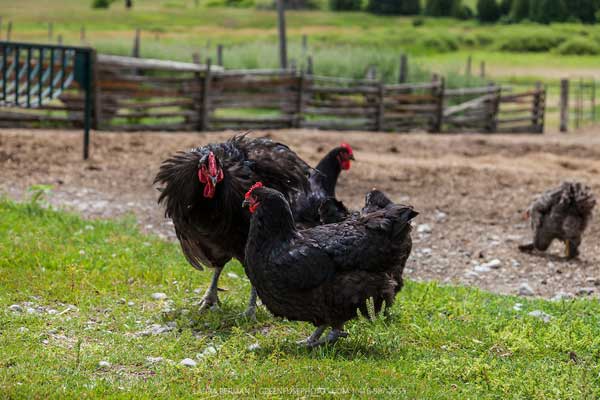

The order is observed in the poultry house and on the walk. To prevent contact of chickens with another bird, cover the aviary on top with a transparent film.
On the walk, it is recommended to sow tall grasses and dig trenches, filling them with ash. Laying hens of the Jersey giant will get rid of parasites on their own by bathing in impromptu dusty baths.
Incubation instinct
The Jersey breed of chickens currently has a well-developed maternal instinct, and with great joy they hatch their chicks.
But, this is that rare case when the instinct of incubating giantess moms cannot be used to reproduce offspring.


These heavyweights are very sloppy sitting on eggs, and most often they destroy them with their large weight even before the chickens have time to develop in them. This makes breeding the species in question available only with the help of an incubator.
Characteristics, maturity and onset of oviposition
The Jersey giants begin to mature at six months of age. Eggs for setting in the incubator are laid from eight months of age.
How to find out how a particular chicken is rushing: in a flying bird, the scallop and lobes look full and smooth, the belly is large and soft (not hard - like an overweight chicken). The skin under the wings is soft, velvety, not covered with scales.
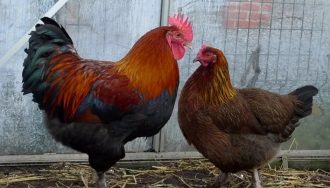

Be sure to read:
Chickens Maran - description of the bird breed with chocolate eggs


Adult roosters of the largest purebred breed of chickens weigh up to 9 kg
There should be a distance of three fingers between the pubic bones, but if there are no two fingers, then the chicken will not be carried.
If you take good care of the chickens, you will not have to waste feed, and there will be chicken on the table regularly.
Some chickens lose their incubation instinct, so a mongrel hen can replace the brood hen.
Giant's appearance
The very name of the Jersey giant chicken breed suggests that the bird is of extraordinary size. The rooster weighs more than 7 kg, and the chicken weighs 5 kg. Giants grow within 18 months.


Jersey can have white and black plumage
The bird has a large head with a leaf-shaped crest and a short powerful beak, sharply curving towards the bottom. The eyes are very dark, almost black. Earrings and lobes are smooth, without wrinkles typical for other chickens. The chest is well developed and protrudes significantly. The bird's back is long and parallel to the ground.
Feet, set wide apart, strong and well developed, with considerable muscles.
Description of the breed
Photo:
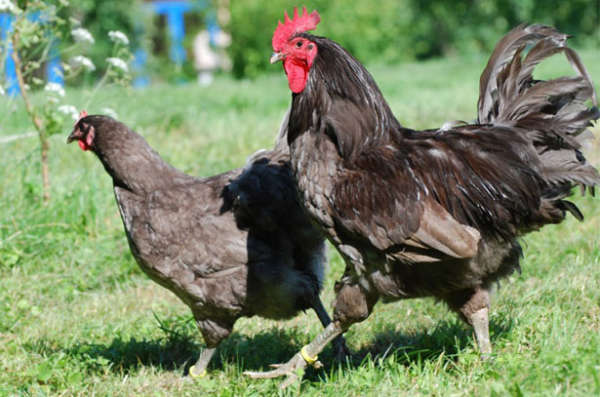

Graceful posture, large size, power, high legs are the distinctive features of the Jersey giant. The breed has 3 main colors: bluish-black, snow-white and fringed ash-blue. Black is the traditional color; the work of German breeders contributed to the appearance of blue.
Chickens of this breed have interesting legs: perfectly developed, muscular, set wide apart, stable, with large legs and thighs. Chickens of the Jersey giant breed are four-fingered.
Their legs and feet range in color from gray to completely black. The color of the paws and the color of the beak is influenced by the main coloring of the bird: in black individuals these parts are absolutely black, in whites they are yellow with dark veins.
Black with a slight yellow beak and the same color of the paws of the blue fringed Jersey Giant chickens. The tips of the toes and the undersides of the feet are lighter in color.
Roosters are characterized by a large, wide head with a vertically arranged six-toothed leaf-shaped comb. Lobes of medium size are smoothly rounded, without wrinkles typical for most chickens. The jersey giant's crest and lobes are bright scarlet.
The beak is strong, curved, short. Convex, round, dark brown, almost black, the bird's eyes are rather large in size. The head is connected to the body by a well-feathered, strong neck.
The horizontal long body is slightly reminiscent of broilers. The enthusiastic looks of true connoisseurs of birds are attracted by their full deep chest, muscular shoulders, broad backs, well-developed belly.
An excellent decoration of the bird is a fairly large and bushy tail, located at an angle of 45 ° relative to the back, formed by sickle-shaped feathers.
Long and wide tail wings of feathers tightly adjoin the sides. They are covered with braids located on top. The dense and smooth main plumage covers the yellow skin.
Chickens, with the exception of sex differences, differ little in appearance from roosters. These beauties are slightly shorter in stature, more stocky, unlike chickens of other breeds, they have a luxurious tail, located lower and more magnificent than that of roosters.
What do chickens need?
Young animals up to the age of 60 days must be kept separate from the rest of the livestock. This can be a separate room or, in general, a room in the owner's house of chickens, if there are not so many birds. Chicks need warmth, lighting, and warm water for drinking.
In the first three days, the chickens are fed with a boiled, mashed egg, based on the fact that one egg is needed for 20 heads. On the fourth day, this component is removed from the diet, and changes to other components.
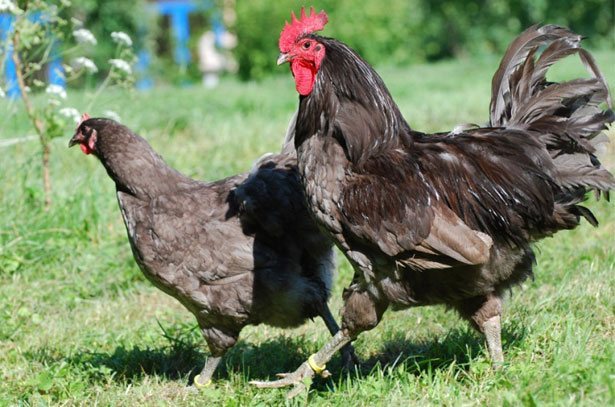

Note to the poultry farmer! In the first 24 hours, chicks may not be interested in food, which suggests that they still have some eggs from original feed in their crop. On the second day, you can begin to expand the diet by adding in quantity and introducing additional ingredients.
The growing young need protein food, they begin to add bone or fish meal, vegetables, roughage in the form of oilcakes and meal, fodder chalk. If we talk about the norm, then on the first day, chickens should receive about 20 grams of food, and about 200 grams by 60 days of life.
Breeding as a business
Breeding features:
- For raising birds, special expensive high-yield feed is used.
- At first you have to invest, but if you approach it correctly, the result will pay off.
- The weight of an adult can be determined in advance by the egg.
- Calculate the weight of the young if necessary. Plus one gram to the weight of the egg is equal to plus one hundred and seventy grams to the weight of the chick.
- Ten to eleven hours after birth, the young are selected.
Advantages and disadvantages
The pluses of the breed include the following features with confidence:
- Meatiness.
- The minimum amount of time to gain weight.
- Disease resistance.
- High survival rates.
disadvantages:
- Consumes a lot of feed.
- Large content space required.
- The need to change the manufacturer.
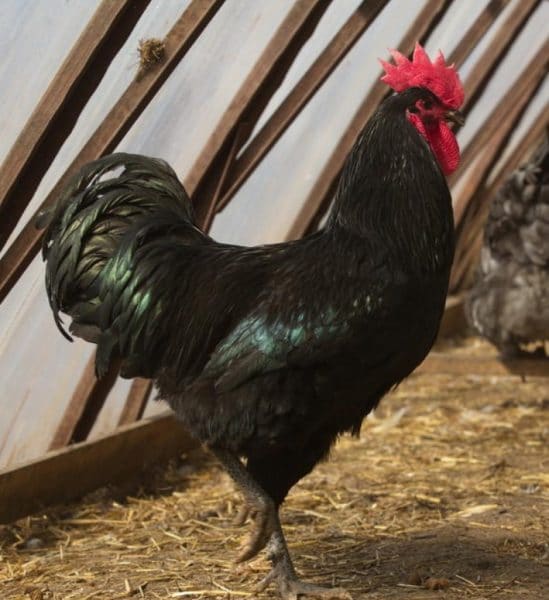

The advantage of giant chickens is that it takes a short period of time to grow.
Diseases
From the first days of life, prevention of morbidity is carried out - chickens receive antibiotics, later antihelminthic drugs are added.
All birds are susceptible to mycoplasmosis, therefore prevention is important: avoiding contact with wild birds and maintaining cleanliness in the chicken coop.
The mesh enclosure is covered with a solid roof made of any material. This will prevent faeces and game feathers from entering.
Important: at any time of the year, every inhabitant of the poultry yard should have an ash heap or bathtub freely available. Bathing in it will prevent the development of parasites on the skin and feathers.

